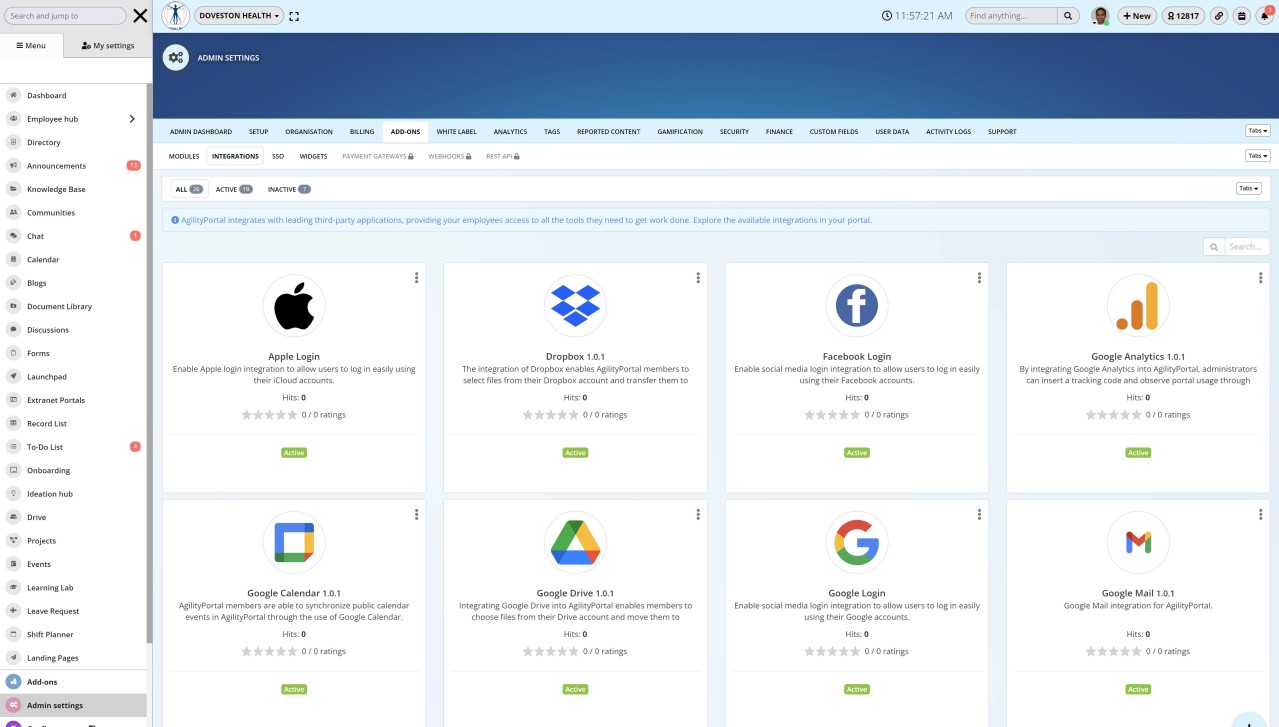Insight Blog
Agility’s perspectives on transforming the employee's experience throughout remote transformation using connected enterprise tools.
7 minutes reading time
(1344 words)
How Can Open APIs Optimize Your Workflows?
Boost productivity with Open APIs! Discover how to automate tasks, foster teamwork, enhance collaboration, and streamline workflows effortlessly.
APIs are the foundation of the digital landscape. As we navigate what is likely to be dubbed the "API decade," all signs point to ongoing expansion in the API market. The growth stemming from new digital ecosystems, SaaS platforms, marketplaces, as-a-service innovations, and the continuous digital modernization of traditional organizations collectively lead to a singular outcome: an increase in APIs.
The surge in API adoption, both internally and externally across organizations, is commonly known as API sprawl. Read on to learn how open APIs can optimize workflows and streamline operations.
What Is Open API?
So, let's get into what API is. "Open API" commonly refers to public APIs, interfaces made accessible to developers for integration into various applications. These APIs are openly available on the internet, allowing developers with requisite programming skills to interact with AI applications. This accessibility fosters efficiency, scalability, and flexibility, enhancing user experiences within open API systems.
For instance, prominent examples of Public APIs include Google Maps API, Twitter API, and Google Search API."open API" can also denote the Open API Specification (OAS). This specification offers a standardized method for documenting and clarifying RESTful APIs, which serve as a lingua franca enabling diverse software applications to communicate and exchange information across the web.
Also known as the Swagger Specification, the Open API Specification functions like an exhaustive user manual detailing every facet of a particular RESTful API's operation. This comprehensive documentation encompasses the API's functionality across its entire lifecycle.
Included within the documentation are essential details such as an overview of the API's purpose, methods of access (like path and query parameters), data handling capabilities (including object properties and data formats), server hosting details (server objects), security prerequisites for API access, and more.
The Open API Specification offers a standardized framework for meticulously documenting the instructions and guidelines necessary for proficiently utilizing a RESTful API. This standardization simplifies comprehension for developers and users alike, enabling seamless API integration into their respective applications.
While not an API itself, the Open API Specification is crucial for documenting and advancing existing API lifecycle models. It equips developers with the insights to comprehend, create, and effectively utilize open APIs.
Understanding the Functionality of Open APIs
Imagine this: your favorite travel app effortlessly suggests restaurants that perfectly match the ambiance of your Spotify playlists.
Or picture your weather app syncing with your smart home thermostat, adjusting the temperature just before a storm rolls in. It's like witnessing magic unfold, all thanks to the seamless exchange of open data, a process known as open data integration.
An open API acts as a bridge between different applications, enabling seamless data exchange like two people conversing fluently in the same language.
Let's get into the mechanics of open APIs to understand the technology powering these interactions—and explore their transformative potential across various industries.
Here's a step-by-step guide to kickstart your journey in open API development by crafting client code to create unique solutions:
- Navigate open API data models: Your software developer discovers open API data models, also known as OpenAPI schemas, available on directories or the provider's website.
- Generate documentation: Access universal API documentation that explains available data, access methods, and security requirements.
- Secure authentication: Obtain credentials, such as API keys, to authenticate access to relevant endpoints, which could be specific data points or functions within the API.Send requests: Your application sends precise requests to the API, specifying the required data or action.
- Receive API response: Retrieve responses typically in JSON or XML formats, which are widely used for data exchange due to their structured nature, containing requested information or confirming actions.Begin integration: Incorporate the API's responses into your application to deliver a seamless user experience.
These steps outline leveraging open APIs to enhance your applications, offering users dynamic and personalized interactions across platforms, sparking excitement and eagerness to implement these solutions.
Make Use of Customer Insights
Usage logging has long been a method to understand how end users interact with various applications. However, too often, the focus is on how users navigate the application rather than identifying the services they find most valuable.
Allowing end-users to integrate your API into their applications allows for analysis of the value you provide to their entire organization, not just individual users. Shifting the analysis to the services utilized rather than application usability enables you to invest in improvements that matter most to your key customers. Utilizing API management tools when sharing your APIs to external users can give you the insights you're missing out on.
For instance, if customers frequently call a service to retrieve the status of a work order, it indicates that they highly value knowing when these orders are processed and completed. If your top 10 customers regularly use this service, it becomes evident that prioritizing enhancements for this service should be a strategic focus for your business roadmap.
Streamline Operations
Besides customers, contemplate internal end users, suppliers, and partners. Picture the possibilities for your organization when you establish a connection between customer requests and an on-demand system that alerts both internal resources and external partners. This integration forms the foundation for a scalable digital business. Automating legal document generation software among various participants allows for seamless requests and responses, shifting away from merely acting as a gatekeeper or, more commonly, an impediment.
Promote Innovation
Web portals and mobile applications come with preset usage expectations. Prioritizing UX allows you to design an application that offers the most value to your end users. However, this also means defining how your service will be used.
By simplifying and opening up the API for customers, partners, and vendors, they might find innovative uses you hadn't anticipated. This could uncover new industries and markets for you to serve.
Giving customers the freedom to interact with the interface as they prefer may lead to creating new products or shared open-source solutions. In some instances, API providers have even adopted functionalities originally developed by their users.
Less Data Entry
Integrating systems streamlines the process of inputting employee data. When you update an employee's information in your HRIS, it seamlessly transfers to other interconnected systems utilizing the same employee data.
For instance, linking your benefits administration tool with your payroll software ensures precise deductions from each employee's paycheck for their specific benefits schemes. This reduction in manual data entry translates to less time dedicated to repetitive tasks and more time allocated to higher-priority activities.
Employee Adoption
Employees are inclined to embrace new technology when easily accessible and updatable; integrated systems facilitate this ease. When employees modify their address in your HRIS, they understand that this change will automatically sync across other pertinent systems, lowering obstacles to maintaining current and precise information.
Collaborative and Familiar API Development
Obscurity doesn't lead to success in the API industry. The greater the collaboration and cohesion among industry best practices, the more beneficial it is for working professionals. API developers are fortunate to have access to OpenAPI Specification (OAS's) open-source environment, where obtaining current information about the specification and its application is easily achievable.
This valuable knowledge is generously shared by top experts in the API field who are dedicated to enhancing the skills of their peers in utilizing the format. This collective effort significantly contributes to enhancing the overall quality of contemporary APIs.
Follow us and access great exclusive content everyday: Follow us on Google News
You may also like: Best Apps for Employees: UPDATED 2022 – A Complete Guide
Free ebook: How To Get Your Intranet Off The Ground
Wrapping up
Open APIs are on the rise in the business landscape, offering valuable functionality to your company. The primary concept is that by developing an open API, you can introduce beneficial features to your business and enable external access to them.
Categories
Blog
(2635)
Business Management
(325)
Employee Engagement
(212)
Digital Transformation
(176)
Growth
(120)
Intranets
(119)
Remote Work
(61)
Sales
(48)
Collaboration
(36)
Culture
(29)
Project management
(29)
Customer Experience
(26)
Knowledge Management
(21)
Leadership
(20)
Comparisons
(6)
News
(1)
Ready to learn more? 👍
One platform to optimize, manage and track all of your teams. Your new digital workplace is a click away. 🚀
Free for 14 days, no credit card required.














